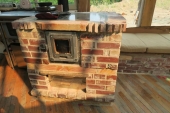Robert Johnson wrote:I was planning on cutting a couple 55 gal barrels in half long ways and filling with perlite to set the rmh on and everything will be set on concrete blocks. Everything will be centered on the house support frames. I'll have corrugated steel covering the walls behind it to reflect the heat into the room. Those will be mounted on 2x4's screwed into the studs and rock wool between the wall and steel. I'll add one barrel of mass at a time to see how much mass I actually need as my house isn't that big.
A few thoughts...
I'd be tempted to weld on a few feet or brackets to keep the half-cut barrel stable, so that it does not want to roll to one side or the other.
Everything I have seen says to leave at least an inch of free air space behind the heat shield. This allows the air to flow behind the metal shield and carry away the heat. If there is no air flow, the temp may keep building higher and higher. There should also be an air gap above and below the face of the air shield, so allow free air movement. Somewhere I came across heat shield recommendations for wood stoves. You might try an Internet search for the details of typical installations.
The ones I saw specified that the stand-offs were non-combustible and also did not convey the heat to the supporting wall. Sounds expensive to me. I've been wondering if a bent C or D shaped piece of metal might act as a suitable stand-off? I'm thinking along the lines of the handles for wood burning stoves and other items that are very close to extreme heat. It seems that they all have in common the ability to quickly shed heat, so that the free air movement carries away heat before it builds up in the handle, or whatever the item is.
Thus, I was thinking that a C or D shaped piece of metal would allow one to bolt it to the sheet metal, on on side of the C- or D-bracket, and then screw that to the wall on the other side. Heat would not carry through to the wall because it would be carried off into the air before it made it to the wall. Sound reasonable??





















































